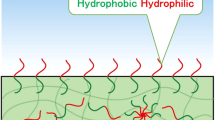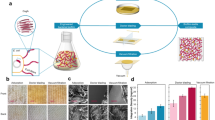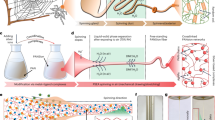Abstract
Brushes are common tools for use in industry and our daily life, performing a variety of tasks such as cleaning, scraping, applying and electrical contacts. Typical materials for constructing brush bristles include animal hairs, synthetic polymer fibres and metal wires (see, for example, ref. 1). The performance of these bristles has been limited by the oxidation and degradation of metal wires, poor strength of natural hairs, and low thermal stability of synthetic fibres. Carbon nanotubes2,3, having a typical one-dimensional nanostructure, have excellent mechanical properties, such as high modulus and strength4,5,6, high elasticity and resilience7, thermal conductivity8 and large surface area (50–200 m2 g−1)9. Here we construct multifunctional, conductive brushes with carbon nanotube bristles grafted on fibre handles, and demonstrate their several unique tasks such as cleaning of nanoparticles from narrow spaces, coating of the inside of holes, selective chemical adsorption, and as movable electromechanical brush contacts and switches. The nanotube bristles can also be chemically functionalized for selective removal of heavy metal ions.
This is a preview of subscription content, access via your institution
Access options
Subscribe to this journal
Receive 12 print issues and online access
$259.00 per year
only $21.58 per issue
Buy this article
- Purchase on Springer Link
- Instant access to full article PDF
Prices may be subject to local taxes which are calculated during checkout




Similar content being viewed by others
References
Dresselhaus, M. S., Dresselhaus, G. & Eklund, P. C. Science of Fullerenes and Carbon Nanotubes (Academic, San Diego, 1996).
Baughman, R. H., Zakhidov, A. A. & de Heer, W. A. Carbon nanotubes-the route toward applications. Science 297, 787–792 (2002).
Poncharal, P., Wang, Z. L., Ugarte, D. & de Heer, W. A. Electrostatic deflections and electromechanical resonances of carbon nanotubes. Science 283, 1513–1516 (1999).
Frank, S., Poncharal, P., Wang, Z. L. & de Heer, W. A. Carbon nanotube quantum resistors. Science 280, 1744–1746 (1998).
Yu, M.-F. et al. Strength and breaking mechanism of multiwalled carbon nanotubes under tensile load. Science 287, 637–640 (2000).
Falvo, M. R. et al. Bending and buckling of carbon nanotubes under large strain. Nature 389, 582–584 (1997).
Kim, P., Shi, L., Majumdar, A. & McEuen, P. L. Thermal transport measurements of individual multiwalled nanotubes. Phys. Rev. Lett. 87, 215502 (2001).
Peigney, A., Laurent, Ch., Flahaut, E., Bacsa, R. R. & Rousset, A. Specific surface area of carbon nanotubes and bundles of carbon nanotubes. Carbon 39, 507–514 (2001).
Wei, B. et al. Organized assembly of carbon nanotubes. Nature 495, 416–417 (2002).
Andrews, R. et al. Continuous production of aligned carbon nanotubes: a step closer to commercial realization. Chem. Phys. Lett. 303, 467–474 (1999).
Cao, A. et al. Direction-selective and length-tunable in-plane growth of carbon nanotubes. Adv. Mater. 15, 1105–1109 (2003).
Hunt, M. R. C. et al. Thermal induced decomposition of single-wall carbon nanotubes adsorbed on H/Si(111). Appl. Phys. Lett. 81, 4847–4849 (2002).
Zhang, F. & Busnaina, A. Submicron particle removal in post-oxide chemical-mechanical planarization (CMP) cleaning. Appl. Phys. A 69, 437–440 (1999).
Nanoscience and Nanotechnologies: Opportunities and Uncertainties www.nanotec.org.uk/finalReport.htm.
Imahori, H. et al. Photoactive three-dimensional monolayers: Porphyrin-alkanethiolate-stabilized gold clusters. J. Am. Chem. Soc. 123, 335–336 (2001).
Murakami, H., Nomura, T. & Nakashima, N. Noncovalent porphyrin-functionalized single-walled carbon nanotubes in solution and the formation of porphyrin-nanotube nanocomposites. Chem. Phys. Lett. 378, 481–485 (2003).
Swift, J. A. & Andrews, J. R. Carbon fiber commutator brush for a toner developing device and method for making. US Patent 6289187B1 (2001).
Wang, X. et al. Anisotropic electrical transport properties of aligned carbon nanotube films. J. Phys. Chem. B 105, 9422–9425 (2001).
Acknowledgements
We thank R. Geier, G. Viswanathan and S. Kar for helpful discussions. This research was supported by the Focus Center New York for Electronic Interconnects and the National Science Foundation Nanoscale Science and Engineering Center for the directed assembly of nanostructures. V. Veedu and M. Nejhad acknowledge the support of ADPICAS project by the Office of Naval Research under the government grant number of N00014-00-1-0692.
Author information
Authors and Affiliations
Corresponding author
Ethics declarations
Competing interests
The authors declare no competing financial interests.
Supplementary information
Supplementary Information
Supplementary figures S1 - S8 (PDF 474 kb)
Rights and permissions
About this article
Cite this article
Cao, A., Veedu, V., Li, X. et al. Multifunctional brushes made from carbon nanotubes. Nature Mater 4, 540–545 (2005). https://doi.org/10.1038/nmat1415
Received:
Accepted:
Published:
Issue Date:
DOI: https://doi.org/10.1038/nmat1415
This article is cited by
-
A Review on Fracture Analysis of CNT/Graphene Reinforced Composites for Structural Applications
Archives of Computational Methods in Engineering (2022)
-
Easily Regenerated Readily Deployable Absorbent for Heavy Metal Removal from Contaminated Water
Scientific Reports (2017)
-
Freestanding foils of nanotube arrays fused with metals
Journal of Materials Science (2014)
-
Highly uniform hole spacing micro brushes based on aligned carbon nanotube arrays
Nanoscale Research Letters (2013)
-
The Structure, Functions, and Mechanical Properties of Keratin
JOM (2012)



